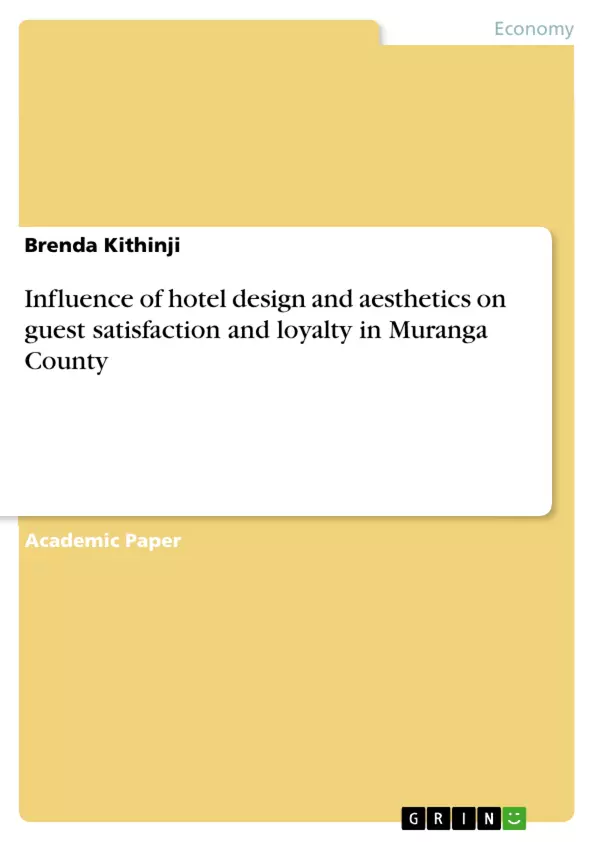The aim of this study was to explore the influence of hotel designs and aesthetics on guest satisfaction and loyalty. Hotel designs and aesthetics play a vital role in shaping guest experience. Hotel designs and aesthetics are components of service scape elements; these are the tangible and intangible elements in the physical environment that guest and employees interact with and influence their behavior response Bitner`s (1992). There have been studies conducted on influence of hotel designs on guest satisfaction, influence of aesthetics on guest satisfaction.
Therefore, existing gap of studies to be conducted on influence of hotel design and aesthetics on guest satisfaction and loyalty especially among hotels in murang`a county. This study sought to understand impact hotel designs and aesthetics influences guest loyalty and satisfaction in hotels among murang`a county.
Inhaltsverzeichnis (Table of Contents)
- DEDICATION STATEMENT
- ACKNOWELDGENT
- TABLE OF CONTENTS.
- LIST OF TABLES
- LIST OF FIGURES...
- ABBREVATIONS AND ACRONYMS...
- DEFINITION OF TERMS.
- ABSTRACT
- CHAPTER ONE
- INTRODUCTION.......
- 1.1Background to the study..
- 1.2Statement of research problem........
- 1.3Purpose of the study.
- 1.4Research questions.
- 1.5Research objectives.
- 1.6Research hypotheses
- 1.7Significance and anticipated output
- 1.8Delimitation and limitation
- 1.9 Conceptual framework.
- CHAPTER TWO
- Literature review
- 2.0 Introduction..........\n
- 2.1
- Theoretical framework.
- 2.1.1 Service scape theory..
- 2.1.2Mehrabian and Russell model..\n
- 2.2 Impact of hotel design and aesthetics on guest satisfaction..
- 2.3 Impact of hotel design and aesthetics on guest loyalty .......
- 2.4Guest satisfaction and loyalty
- 2.5 Summary of reviewed related literature and research gaps...\n
- CHAPTER THREE
- Research methodology
- 3.1 Research design.........
- 3.2Variables........
- 3.3Location of the study...\n
- 3.4Study population
- 3.5Sampling technique.
- 3.6Sample size determination
- 3.7Pretesting..
- 3.8Validity and reliability .\n
- 3.9 Data collection..\n
- 3.10Data analysis
- 3.11Logistical and ethical considerations\n
- CHAPTER FOUR
- FINDINGS
- 4.0Introduction..\n
- 4.1 Response.......
- 4.2Respondent's demographic characteristics.
- 4.2.1 Respondent's gender.
- 4.2.2Respondent's age............\n
- 4.2.3respondent's education level
- 4.2.4Frequency of hotel visits.
- 4.2.5Primary purpose for visiting the hotel..\n
- 4.3Question one: how does hotel design impact guest satisfaction and loyalty?\n
- 4.4 Question two: what is the role of aesthetics in creating a memorable and enjoyable guest experience?...\n
- 4.5 Question three: Is there a relationship between hotel designs and overall guest satisfaction and loyalty through feedback and guest reviews?.\n
- 4.6 Question four: How does hotel design and aesthetics impact guest loyalty and the likelihood of repeat visits and positive recommendations?..\n
- CHAPTER FIVE
- DISCUSSIONS, CONCLUSION AND RECOMMEDATIONS.
- 5.0Introduction ........
- 5.1 Discussion\n
Zielsetzung und Themenschwerpunkte (Objectives and Key Themes)
This research aims to understand how hotel design and aesthetics influence guest satisfaction and loyalty among hotels in Murang'a County. The study aims to investigate the specific elements of design and aesthetics that contribute to positive guest experiences, as well as the impact of these factors on guests' likelihood to recommend the hotel and return for future stays.
- The impact of hotel design on guest satisfaction and loyalty.
- The role of aesthetics in creating a memorable and enjoyable guest experience.
- The relationship between hotel design and overall guest satisfaction and loyalty through feedback and guest reviews.
- The impact of hotel design and aesthetics on guest loyalty and the likelihood of repeat visits and positive recommendations.
Zusammenfassung der Kapitel (Chapter Summaries)
- Chapter 1: Introduction - This chapter sets the stage for the research by providing background information on the hospitality industry, highlighting the importance of guest satisfaction and loyalty. The research problem is clearly stated, outlining the need for this investigation. The study's purpose, research questions, objectives, and hypotheses are presented, along with its significance and anticipated outcomes. The chapter concludes with a discussion of the study's delimitation, limitations, and the conceptual framework that guides the research.
- Chapter 2: Literature Review - This chapter delves into existing literature on hotel design and aesthetics, examining their impact on guest satisfaction and loyalty. Key theoretical frameworks, such as the service scape theory and the Mehrabian and Russell model, are discussed, providing a foundation for understanding the relationship between physical environment and guest experiences. The chapter also explores previous research findings on how specific design elements influence guest satisfaction and loyalty, highlighting the connection between the two.
- Chapter 3: Research Methodology - This chapter outlines the research design employed for this study, including the variables investigated, the location of the research, and the study population. The sampling technique used for data collection is explained, along with the methods used to determine the sample size. This chapter also addresses pretesting procedures, validity and reliability considerations, and the data collection methods employed. The data analysis techniques are described, and the logistical and ethical considerations involved in the research process are discussed.
- Chapter 4: Findings - This chapter presents the results of the research, analyzing the data collected through questionnaires and interviews. The demographic characteristics of the respondents are presented, and the results are discussed in relation to the research questions posed. The chapter examines the relationship between hotel design elements, guest satisfaction, and loyalty, providing insights into how design influences guest experiences. The findings highlight the impact of aesthetics on guest perceptions and the role of design in creating memorable and enjoyable experiences.
Schlüsselwörter (Keywords)
The key terms and concepts explored in this research include hotel design, aesthetics, guest satisfaction, guest loyalty, service scape theory, Mehrabian and Russell model, hospitality industry, Murang'a County, guest experience, and empirical research findings.
- Quote paper
- Brenda Kithinji (Author), 2024, Influence of hotel design and aesthetics on guest satisfaction and loyalty in Muranga County, Munich, GRIN Verlag, https://www.grin.com/document/1481852



